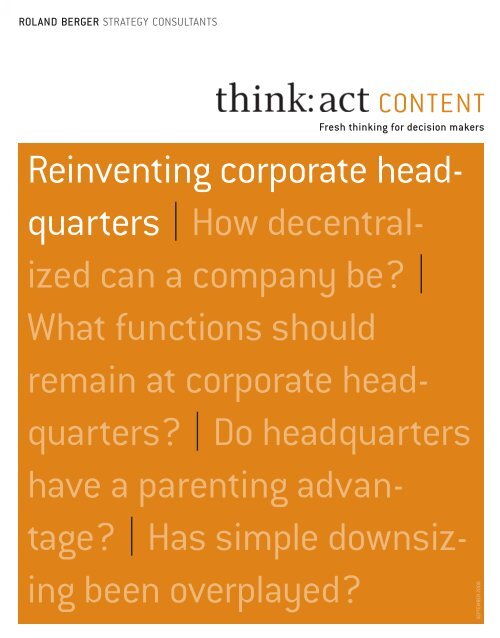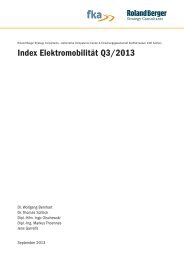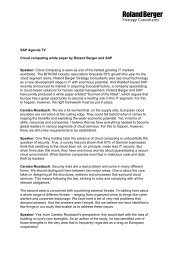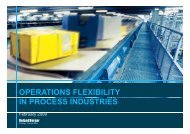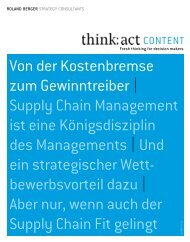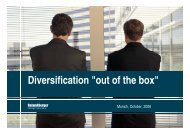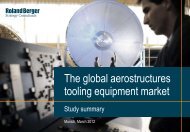act CONTENT "Reinventing corporate headquarters" - Roland Berger
act CONTENT "Reinventing corporate headquarters" - Roland Berger
act CONTENT "Reinventing corporate headquarters" - Roland Berger
Create successful ePaper yourself
Turn your PDF publications into a flip-book with our unique Google optimized e-Paper software.
ROLAND BERGER STRATEGY CONSULTANTS<strong>CONTENT</strong>Fresh thinking for decision makers<strong>Reinventing</strong> <strong>corporate</strong> headquarters| How decentralizedcan a company be? |What functions shouldremain at <strong>corporate</strong> headquarters?| Do headquartershave a parenting advantage?| Has simple downsizingbeen overplayed?SEPTEMBER 2006
ROLAND BERGER STRATEGY CONSULTANTS"Little academic research has been done on the topic eventhough it is clearly of interest to CEOs and often is a focus of their<strong>act</strong>ivities, particularly early in their tenure. As a result, reductionsin <strong>corporate</strong> headquarters are often very visible decisions."David J. Collis, Harvard Business SchoolAt the headquarters of a leading logisticscompany, only 0.3 full-time employees havebeen assigned to strategic planning– very few for such an important function.57%One electronics7060 50 40 30 20 10 0 10manuf<strong>act</strong>urer rigorouslyfocuses onresearch and development57% of theemployees at headquartersfocus onthis strategic area.The signs are too obvious to be overlooked. No sooner had he taken office, than newDaimlerChrysler boss Dieter Zetsche announced a radical shake-up at <strong>corporate</strong> HQ. He eveninformed the workforce that they would be moving back to the old main building. Corporatefunctions are now following in the footsteps of production. Every possible avenue is beingexplored to intelligently reduce the headcount, make workflows more flexible, outsource<strong>act</strong>ivities at low cost and make processes even more efficient. 6,000 jobs are to be cut – a20% reduction – in the space of two years. Billions are to be saved in either year. Meanwhile,T-Com, Deutsche Telekom’s landline business, is planning even more drastic changes. Itsmanagement wants to see <strong>corporate</strong> functions completely reshuffled. In their view, only1,200 of the 8,000 staff who currently populate the company’s Bonn headquarters shouldstill be there at the end of the day.The f<strong>act</strong> that such moves are being made comes as no surprise. Both employees and thepublic at large have long expected them. Corporate HQs everywhere are perceived – bothinternally and externally – to be vulnerable. More and more questions are being raised aboutthe "parenting advantage", about the value they add to their respective companies. Whateverthe tasks and resources assigned to these units, stakeholders are baying for far more efficientand effective structures. What is surprising are the reasons being put forward by managers.Zetsche claims to want to "unleash DaimlerChrysler’s full potential" with a leaner HQ,while the T-Com management says its new structure will let the company "improve the serviceit provides to customers".These examples clearly show that more is at stake here than cost-cutting. In future, necessarychanges will no longer only be effected by, but also at, <strong>corporate</strong> headquarters. Hitherto,this has tended to be the exception. Now, all the signs indicate that a new trend is emerging:Lean HQs and decentralized companies are evidently the order of the day. BP CHIEF LORD BROWNE made waves when he literally flattened the hierarchy at hisgroup’s headquarters. He ejected a whole layer of management and brought line managersout of the shadows, getting them to report directly to the board. The result? Performancerose sharply in the lines – and costs were slashed by 30%.8.7% 1.9%A German commercial bank works with a stronglycentralized structure and employs 8.7% of allemployees at headquarters. However, a Swisscompetitor uses a successful shared servicesapproach and employs no more than 1.9% of itsworkforce at headquarters. IBM BOSS LOUIS GERSTNER has broken up Big Blue’s structures to such an extentthat 40% of the group’s 320,000-strong global workforce are now completely mobile. Today,they only sporadically put in an appearance at an IBM office. In the process, Gerstner hastransformed a lurching Colossus into a "Solution Company" that is astonishingly flexible fromtop to bottom. The results speak for themselves.Most of the decision-makers we surveyed are now aware that similar tasks lie ahead of themtoo. Every three years, our studies of <strong>corporate</strong> headquarters quiz Europe’s leading companieson three issues: basic management models, structural char<strong>act</strong>eristics and the size of
<strong>CONTENT</strong>R e i n v e n t i n g C o r p o r a t e H e a d q u a r t e r stheir overhead functions. Three years ago, everyone was talking about centralizing andstreamlining their functions. Today, however, two out of three respondents recognize theneed to distribute their companies’ overhead functions more widely.STRATEGIC DILEMMAIn downsizing their <strong>corporate</strong> headquarters, however, managers wrestle with a dilemma. Inthe one corner are the benefits of centralization: lower trans<strong>act</strong>ion costs, economies of scaleand the like. In the other corner are the benefits of decentralization: efficiency gains as hierarchiesare dismantled, plus the ability to respond more flexibly to the market. So which sideis going to win the fight?The short answer is "both sides". Excellent companies intelligently combine both sets of benefitsto deliver superior performance at lower cost.The most critical advantage of a decentralized organization is thorough and distributedknowledge about the market. The real entrepreneurial types can find their calling in small,effective business units. They get to make front-line market decisions quickly, motivateemployees, and expand areas of expertise – all according to their business vision.Achieving this winning combination is a matter of endowing such a multi-branched unitstructure with a load-carrying backbone. Structural support for a decentralized organizationincludes effective auditing systems, as well as overlapping management and service units.All of which, however, leads to new challenges for <strong>corporate</strong> headquarters. Central functionshave to successfully balance decentralization and cost efficiency. They concentrate administrativeand other valuable services from across the company and provide these to the decentralizedunits. They are cost-efficient because they sustainably realize scale effects. Aboveall, they are a prerequisite for future steps to optimize the <strong>corporate</strong> group.The future belongs to decentralized organizations because they will be able to tap moregrowth opportunities. Striking the right balance between decentralization and maximizingthe benefits of scale is no simple matter. It requires every function, every managementprocess, every link in the value chain to formulate a customized strategy for each companyand market.66%of all companies participating in the CorporateHeadquarters Study expect European companiesto have more decentralized organizations in thefuture. In past surveys, the majority of respondentsopted for a more centralized structure.TOP 5 FUNCTIONS FOROUTSOURCING (%)LEVEL OF OUTSOURCING (%)TOP 5 FUNCTIONS IN SHAREDSERVICE UNITS (%)Legal3953IT24ITReal estate/facilitymanagement3955Human resources212939AccountingPurchasing andprocurementReal estate/facilitymanagement17Human resourcesCommunication282823371713Percentage of companies that outsource <strong>corporate</strong>functions mentioning the respective functionSource: <strong>Roland</strong> <strong>Berger</strong> "Corporate Headquarters 2005" studyAverage outsourcing degree by companiesthat outsource <strong>corporate</strong> functionsPercentage of functions mentioned by companieswith shared service units
ROLAND BERGER STRATEGY CONSULTANTS[SIZE]Analyzing our benchmarking database, we found very differentlevels of homogeinity depending on the functional category.BENCHMARKING OVERVIEW OF ALL FUNCTIONSValues for all participating companies. Headcount of HQas ‰ of total company headcount.Company managementStrategic planning/<strong>corporate</strong> developmentCommunicationsInvestor relationsMergers&acquisitionsLegalPatents and licensesAuditingOrganizational development/consultingFinanceControllingAccountingInsuranceTaxesInternational trade and customsHuman resourcesITOccupational safety and environmental protectionReal estate/facility managementGeneral servicesResearch and developmentPurchasing and procurementLogisticsQuality managementMarketing and salesMedian Min. Max.1.25 0.03 10.70.35 0.01 5.830.73 0.03 7.770.10 0.01 3.130.13 0.03 0.800.58 0.05 9.050.18 0.03 4.190.33 0.05 4.780.55 0.04 10.40.71 0.04 9.301.07 0.04 15.31.78 0.09 45.60.23 0.03 1.280.29 0.01 5.450.21 0.01 1.792.07 0.05 38.14.79 0.03 52.10.48 0.02 4.990.85 0.01 1230.75 0.01 15.83.13 0.04 2642.39 0.03 15.53.94 0.11 25.01.32 0.03 37.32.10 0.02 118Operational functions HR & system support Finance functionsStrategic/Corporate functions
<strong>CONTENT</strong>R e i n v e n t i n g C o r p o r a t e H e a d q u a r t e r sSHARED SERVICES – A SUCCESSFUL MODELShared service units are a good example of how this principle can work. Bundling knowledge(through standardization, for example) raises quality and reduces costs. Compared to traditionaloutsourcing models, however, shared service centers hold out an added advantage inthat sensitive data remains inhouse. Accordingly, shared service models are today significantlyinfluencing moves to slim down <strong>corporate</strong> HQs. Over one third (38%) of the companieswe surveyed today organize parts of their <strong>corporate</strong> functions as shared service units – upsharply from 17% in 2002. IT and HR are the main functions that are realigned in this way.The benefits of shared service units are: COST MONITORING: Time, quality and costs are contr<strong>act</strong>ually defined RELIABLE PLANNING: Internal customers can rely on the promises made SERVICE QUALITY: Service centers have to sell their services as products COMPETITION: Internal customers can solicit bids from external service providers MOTIVATION: Outstanding performance becomes visible and can be rewarded as such INTERNAL RESOURCES: Sensitive information can be kept inhouseINDISCRIMINATE DOWNSIZING IS A DANGEROUS GAMEIn recent years, many companies have centralized ever more extensive <strong>act</strong>ivity sets in orderto reap economies of scale. This has not automatically led to bloated HQs, however. On thecontrary, new technologies and constant pressure to streamline have <strong>act</strong>ually reduced theheadcount at <strong>corporate</strong> headquarters.The functions retained at <strong>corporate</strong> HQ nevertheless have to maintain a certain size if theyare to work effectively and add value for the company.Paradoxically, there are many cases where over-zealous downsizing has left key <strong>corporate</strong>functions too small to truly do justice to <strong>corporate</strong> and management strategies. Our studyshows that the primary victims are usually strategic functions such as strategic planning,organizational development and investor relations.To take an example: At almost every second HQ that claimed a strategic management role,the Strategic Planning unit had less than five people. One of the largest and leadinglogistics companies in Europe assigned just 0.3 of a full-time equivalent to this function –a glaring discrepancy between claim and reality, and in all likelihood not enough for suchan important function.In their study of 600 companies, David J. Collis of the Harvard Business School and MichaelGoold of the Ashridge Institute showed how indiscriminately reducing the headcount canseriously harm companies in the medium term. According to their study, companies withabove-average profits had <strong>corporate</strong> functions that were around 20% larger than those ofcomparable but less profitable firms.One reason, in the view of the Harvard professors, is the value added by <strong>corporate</strong> functions.They argue, for example, that the large R&D department anchored in Pfizer’sheadquarters adds crucial value to the drug company. Collis and Goold also believe thatUnilever’s comparatively large HR department does a fine job of churning out exceptionallywell trained executives.21.8%Introducing a shared service centerhas reduced the cost of support functionsof an energy provider by 21.8%ROOM FOR IMPROVEMENTSimply downsizing is not a solution, according to a studyby the Harvard Business School. In Europe and Japan,where the number of employees working at headquarterswas considerably reduced, performance of headquarterswas rated poorly. By contrast, in the USA, where the majorityof headquarters increased in size, performance wasconsistently awarded good marks.CHANGE IN NUMBER OF HQ STAFFOVER PREVIOUS FIVE YEARS43%54%44%50%30%GERFRAUKJPNUSA28%24%25%9%50%-27% GERMANY-49% FRANCE-52% UKLOWER-52% JAPANSource: Harvard Business School, 2003HIGHEROVERALL EFFECTIVENESS OF CORPORATEHEADQUARTERS (+ GOOD ; - NEEDS IMPROVING)+20% USA
ROLAND BERGER STRATEGY CONSULTANTSBIGGER WORKLOAD, LESS PEOPLEAs <strong>corporate</strong> functions have been centralized, thenumber of HQ employees declined.LEVEL OF CENTRALIZATION (%)Strong uptrend75662000-20022003-2005NUMBER OF EMPLOYEES (%)Slight downtrend##2.18 2.112000-20022003-2005The data in our studies of <strong>corporate</strong> headquarters points to similar findings at European companies.Indiscriminate downsizing that takes no account of overhead processes and contentadversely affects a company’s profitability. It follows that, when designing (and sizing) <strong>corporate</strong>functions, the question of effectiveness ("Is the function doing the right things?")should take precedence over the question of efficiency ("Is the function doing thingsright?"). The conclusions drawn will influence both costs and sales. In other words, carefullyexamining how core processes are organized and clarifying who is responsible – a central ora decentralized unit – can have a huge imp<strong>act</strong> on overall <strong>corporate</strong> performance.BOTTOM UP INSTEAD OF TOP DOWNIncreasingly, companies are finding that they can combine the benefits of centralization(the competence to issue guidelines and the ability to bundle purchasing power, etc.) withthe benefits of a distributed structure that is more responsive to the market. Modern communicationtechnologies and flexible, innovative virtual office models facilitate this mix.But what does all this mean in pr<strong>act</strong>ice to the design of <strong>corporate</strong> headquarters? Our experienceshows that a greenfield approach is the best way to combine the benefits of centralizationwith the benefits of decentralization. The resultant target model can then deliver anoptimized <strong>corporate</strong> HQ structure. Our greenfield approach begins by asking some simplequestions:A) What is the future <strong>corporate</strong> management model?B) What tasks is HQ to handle in future? What tasks would be better performed elsewhere?C) How and where can these tasks be bundled sensibly?D) Which people and how many people will these new departments need?BIG BEN – ROLAND BERGERBENCHMARKING DATABASE Corporate center data culled from 241 companies(including relative levels of centralization andoutsourcing) is safely stored in our benchmarkingdatabase. Some of the data has been piecedtogether from high-quality interviews conductedduring <strong>corporate</strong> development projects.Supplementary information derives from thestudies of <strong>corporate</strong> headquarters thatwe performed in 1999, 2002 and 2005.The database thus enables enterprisespecificbenchmarking panels to be producedfor 29 core functions and 120 subfunctions.It can therefore set the ballrolling, stimulat-ing a meaningful discussionof key f<strong>act</strong>ors and sizing issues.It is especially important to accurately anticipate capacity requirements ahead of a reorganizationin order to minimize operating risks. However, it is not always helpful to draw on rawnumbers such as the size of the overall workforce. A <strong>corporate</strong> communications departmentwill not expand continually in line with company growth. Instead, it will grow intermittently asdifferent requirements thresholds are reached and crossed. Acquisitions can suddenlynecessitate the formation of an international team. New legal forms may change the requirementsfor disclosure and reporting. And changes in the media landscape may create a needfor specialists to handle new media.A more sensible way of working toward the optimal constellation is to analyze benchmarkdata. Our view is that it is best to look for patterns that cut across different industry lines. Wehave grouped <strong>corporate</strong> functions into the following clusters:1.) STRATEGIC/MANAGEMENT FUNCTIONS, e.g. management board, strategic planning,investor relations, <strong>corporate</strong> communications2.) FINANCIAL FUNCTIONS, e.g. finance, controlling, accounting, insurance3.) BUSINESS SYSTEM SUPPORT FUNCTIONS, e.g. HR, IT, facility management,occupational safety4.) OPERATING FUNCTIONS, e.g. research &development, purchasing, logistics,qualitymanagement
<strong>CONTENT</strong>R e i n v e n t i n g C o r p o r a t e H e a d q u a r t e r sOur studies and analyses suggest that the first two function clusters follow a very uniformpattern across all industries, company sizes and management models. This finding is all themore remarkable given that not even varying numbers of business units appear to correlatedirectly to the size of these functions.The third cluster too fluctuates within a relatively narrow corridor when one compares the sizeof these functions with a company’s total workforce. In the fourth cluster (operating functions),the pivotal role is played by the specific industry and business model. For this cluster,it therefore makes sense to benchmark functions against a comparable panel of companiesthat operate similar business systems and management models in the same industry.We believe there is also another reason why it makes sense to draw comparisons with otherindustries. In terms of the perceived core functions they perform, individual overheadfunctions are very definitely comparable across industries. The analogies can, indeed, besurprising.Let us look at just one example. At a high-tech company, the IT department is central to theprocess of adding value. The same is true at a commercial bank. In this case, therefore,cross-industry benchmarking makes eminent sense. It is also worth asking why the<strong>corporate</strong> HR departments at service providers have to be so much bigger than those atindustrial companies of a comparable size. Conversely, industrial companies can learn lessonsfrom service providers too. In recent years, the latter have done a far better job ofstreamlining their <strong>corporate</strong> accounting functions.In our experience, the insights gained from individual benchmarking exercises invariablyspark off fruitful discussions. Very quickly, companies then realize how certain functions canbe made to add more value for the company.DO YOU HAVE ANY QUESTIONS,IDEAS OR COMMENTS?WE WOULD BE HAPPY TO HEAR FROM YOU!Tim Zimmermann,Partner+49 89 9230-8362Tim_Zimmermann@de.rolandberger.comBjörn Witte,Project Manager+49 89 9230-8844Bjoern_Witte@de.rolandberger.comFabian Huhle,Senior Consultant+49 89 9230-8486Fabian_Huhle@de.rolandberger.comCOMPANIES HAVE TO TAKE ACTION NOW!"Business fashions" (such as outsourcing) and supposed patent recipes (such as deconstructingthe value chain) all have their limits, as we have clearly seen in the past few years.We believe that now is the time for companies to home in on their core tasks and make individualfunctions more effective. Despite the growing trend toward decentralization, closerattention will again be paid to <strong>corporate</strong> headquarters in future. Up to now, few companieshave grasped the true potential of radical reorganization. Yet that is precisely the issue atstake right now. Companies that depend on a flexible and efficient global organization butthat also want to keep their finger on the pulse of the market know that they have to keepreinventing themselves. But they also have to keep reinventing their <strong>corporate</strong> headquarters.Experience gained from cross-industry analyses is fueling this renewal process. Based on allthat we have seen, we believe that old paradigms (central or decentralized, strategic or operational,etc.) will give way to a refreshing new pragmatism. Can cumbersome giants be transformedinto dynamic and flexible organizations? Yes, we believe they can!think:<strong>act</strong> <strong>CONTENT</strong>Publishers: Burkhard Schwenker, António BernardoOverall responsibility: Torsten OltmannsProject management: Carsten Matthäus<strong>Roland</strong> <strong>Berger</strong> Strategy ConsultantsAm Sandtorkai 4120457 Hamburg+49 40 37631-40news@rolandberger.com


